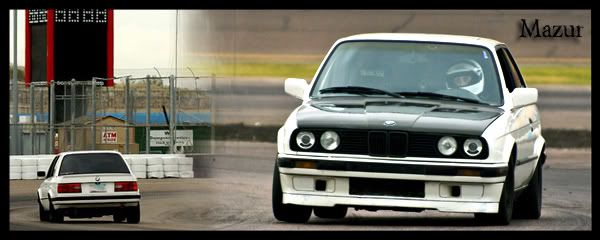For $25...:)
I've been researching DIY alignments for past couple days and today decided to rig up a "smart strings" type contraption.
Parts:
-2x 8' aluminum C "tube" (imagine a square missing one wall)
-3' aluminum flat bar.
Basically I just cut off one foot off each C tube and cut them in half. To these I attached pieces of flat bar (which I had cut into 4 pieces). This part would be made to rest on the ends of the C tubes and be positioned however desired.
Then I just marked the exact center of each piece and mounted to exact center of rear and front of the car via painters tape on top of the bumpers(which is stupid easy with the kidney grills and rear roundel). Then proceded to put on the fishing line.
This is a very simple, but effective device. The most important thing is EXACT MEASUREMENTS.
--------------------------------------------------------------------
**Before alignment I had done a corner balance which really screwed up the alignment (ex. 100#'s was shifted away from FL corner and added to the right!) Plus, my car has always pulled pretty hard to the right with steering wheel off-center**
With my mom sitting in the car (she weighs the same as I), I first measured the difference of camber from right to left wheel. To do this I used a straight edge standing against base of tire and measuring distance to it from top lip of the wheel. Camber was off by .5'', so I just increased the side that had more positive camber. *Will need to go to alignment rack or buy camber measuring tool to get actual measurement in degrees*
Roll car back and forth and bounce on it to settle the suspension and redo measurements to confirm.
Next, you take the difference measured from center back and front of the wheels lip to the string and you will get your toe. It being +/- should be obvious...
Before- L: +1/8'' R:+1/16'' (right was a lot more positive before adding negative camber)
After- L:-1/16'' R:-1/16''
(- is toe out, + is toe in)
*suspension settled after each adjustment*
Results: AWESOME!!! Car actually goes straight down the road and wheel centered. And can't believe how good it feels after a corner balance and alignment in the fast corners (60-80mph):crazy:
Oh...here are some pics...lol
And please don't use tape for the flat bar like I did unless you're sure they're square (90* angle with C tube piece) and using steel is preffered since it won't bend. Like aluminum.


I've been researching DIY alignments for past couple days and today decided to rig up a "smart strings" type contraption.
Parts:
-2x 8' aluminum C "tube" (imagine a square missing one wall)
-3' aluminum flat bar.
Basically I just cut off one foot off each C tube and cut them in half. To these I attached pieces of flat bar (which I had cut into 4 pieces). This part would be made to rest on the ends of the C tubes and be positioned however desired.
Then I just marked the exact center of each piece and mounted to exact center of rear and front of the car via painters tape on top of the bumpers(which is stupid easy with the kidney grills and rear roundel). Then proceded to put on the fishing line.
This is a very simple, but effective device. The most important thing is EXACT MEASUREMENTS.
--------------------------------------------------------------------
**Before alignment I had done a corner balance which really screwed up the alignment (ex. 100#'s was shifted away from FL corner and added to the right!) Plus, my car has always pulled pretty hard to the right with steering wheel off-center**
With my mom sitting in the car (she weighs the same as I), I first measured the difference of camber from right to left wheel. To do this I used a straight edge standing against base of tire and measuring distance to it from top lip of the wheel. Camber was off by .5'', so I just increased the side that had more positive camber. *Will need to go to alignment rack or buy camber measuring tool to get actual measurement in degrees*
Roll car back and forth and bounce on it to settle the suspension and redo measurements to confirm.
Next, you take the difference measured from center back and front of the wheels lip to the string and you will get your toe. It being +/- should be obvious...
Before- L: +1/8'' R:+1/16'' (right was a lot more positive before adding negative camber)
After- L:-1/16'' R:-1/16''
(- is toe out, + is toe in)
*suspension settled after each adjustment*
Results: AWESOME!!! Car actually goes straight down the road and wheel centered. And can't believe how good it feels after a corner balance and alignment in the fast corners (60-80mph):crazy:
Oh...here are some pics...lol
And please don't use tape for the flat bar like I did unless you're sure they're square (90* angle with C tube piece) and using steel is preffered since it won't bend. Like aluminum.





 .
.

Comment